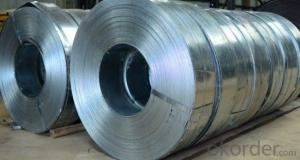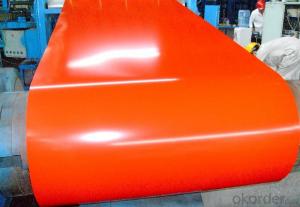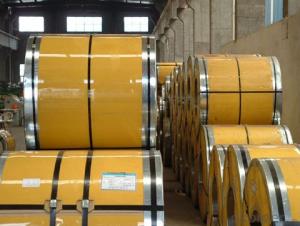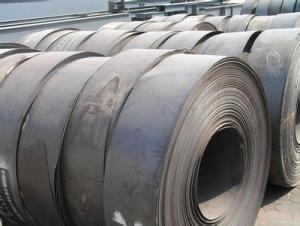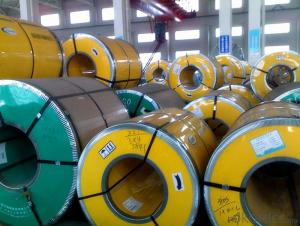Galvanized Steel Strip with High Quality-SGCC 630*0.8mm
- Loading Port:
- China main port
- Payment Terms:
- TT OR LC
- Min Order Qty:
- 50 m.t
- Supply Capability:
- 10000 m.t/month
OKorder Service Pledge
OKorder Financial Service
You Might Also Like
Galvanized Steel Strip with High Quality-SGCC 630*0.8mm
Product Description:
Specifications:
1. Thickness: 0.8mm
2. Width: 630mm
3. Material: SGCC
4. ID: 508mm or 610mm
5. Spangle: Regular spangle or zero spangle
6. others: chromated or no chromated; oiled or no oiled.
Advantages of Galvanized Steel Strip with High Quality-SGCC 630*0.8mm:
1. Uniform coating;
2. Strong adhesion;
3. Strong corrosion resistant ability
Usage of Galvanized Steel Strip with High Quality-SGCC 630*0.8mm:
1. Making pipes, like Greenhouse tubes, drinking water pipe, heating pipe, gas pipe and so on;
2. Used in automobile;
3. Used in construction;
4. Used in agriculture, fishery and so on.
FAQ of Galvanized Steel Strip with High Quality-SGCC 630*0.8mm:
Q1: How soon can we receive the product after purchasement?
A1: Within three days of placing an order, we will begin production. The specific shipping date is dependent upon international and government factors, but is typically one month-two months.
Q2: How do you guarantee the quality of our products?
A2: We have established an advanced quality management system which conducts strict quality tests at every step, from raw materials to the final product. At the same time, we provide extensive follow-up service assurances as required.
Q3: The prices are invoicing on theoritical weight or on actual weight?
A3: We can do it in both manners, according to the customers' request.
Images of Galvanized Steel Strip with High Quality-SGCC 630*0.8mm:
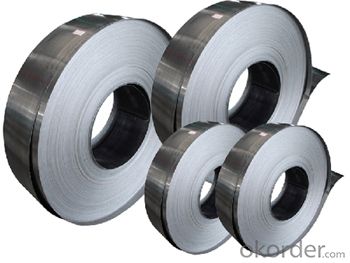
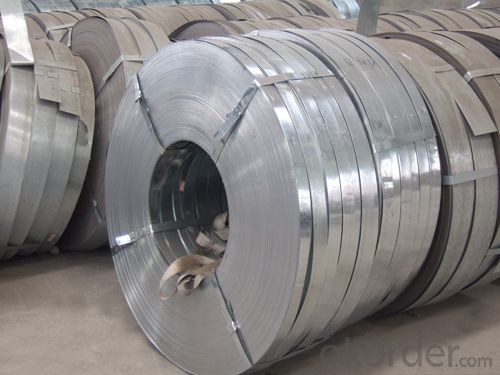
- Q:How are steel strips used in the manufacturing of medical devices?
- Due to their unique properties such as strength, durability, and corrosion resistance, steel strips have found wide usage in the manufacturing of medical devices. These strips are typically composed of stainless steel, an alloy renowned for its exceptional mechanical and chemical characteristics. In the medical device industry, steel strips serve a multitude of purposes. One common application is their use in producing surgical instruments like scalpels, forceps, and scissors. These instruments require a sturdy and sharp edge, which can be achieved by shaping and sharpening the steel strips. The stainless steel composition ensures that the instruments remain resistant to corrosion, reducing the risk of contamination during medical procedures. Moreover, steel strips are employed in the production of medical implants such as pacemakers, joint replacements, and spinal fixation devices. These implants necessitate robustness and biocompatibility to ensure long-term functionality and patient safety. Steel strips provide the requisite strength for these implants, enabling them to withstand the forces and stresses they may encounter within the human body. Additionally, steel strips find use in fabricating medical equipment, including imaging devices like X-ray machines and MRI scanners. These devices demand a stable and rigid structure to maintain accuracy and precision. Steel strips offer the necessary structural integrity, facilitating the precise alignment of components and ensuring optimal performance of the equipment. Furthermore, steel strips are utilized in the manufacturing of medical tubing, catheters, and stents. These devices often require a combination of flexibility and strength to navigate through the intricate pathways of the body. Steel strips can be shaped and formed into thin tubes or wires, enabling the production of flexible yet sturdy medical devices. In conclusion, steel strips play a vital role in the manufacturing of medical devices. Their strength, durability, and corrosion resistance make them an ideal material for various applications in the medical industry. Whether it is for surgical instruments, implants, medical equipment, or tubing, steel strips contribute to the production of high-quality and reliable medical devices that enhance patient care and improve medical outcomes.
- Q:Can steel strips be used in the food processing industry?
- Yes, steel strips can be used in the food processing industry. They are commonly used for various applications such as cutting, packaging, and handling of food products due to their durability, hygiene, and resistance to corrosion.
- Q:What is the difference between galvanized and zinc-coated steel strips?
- Galvanized steel strips and zinc-coated steel strips are frequently used interchangeably, but there exists a subtle distinction between the two. Both types of steel strips possess a zinc layer that safeguards the underlying steel against corrosion. Galvanized steel strips feature a pure zinc layer, which is achieved through either a hot-dip galvanizing process or electroplating. This generates a thick and long-lasting zinc layer that offers exceptional resistance against corrosion. Galvanized steel strips find widespread use in outdoor settings or environments with high humidity or exposure to corrosive elements. In contrast, zinc-coated steel strips are coated with a zinc alloy layer, typically a combination of zinc and other elements like aluminum or magnesium. This alloy coating provides improved resistance against corrosion compared to pure zinc, making it suitable for more demanding applications. Zinc-coated steel strips are commonly employed in industries such as automotive, construction, and manufacturing, where durability and corrosion resistance are paramount. To summarize, although both galvanized and zinc-coated steel strips provide corrosion protection, the distinction lies in the composition of the coating. Galvanized steel strips possess a pure zinc coating, while zinc-coated steel strips have a zinc alloy coating. The choice between the two depends on the specific application and the desired level of corrosion resistance.
- Q:Can steel strips be used in electrical motors?
- Yes, steel strips can be used in electrical motors. Steel strips are commonly used as laminations in the core of electrical motors to reduce energy losses caused by eddy currents and improve overall motor efficiency.
- Q:What are the storage guidelines for steel strips?
- To ensure the longevity and prevent damage of steel strips, it is important to adhere to storage guidelines. Firstly, it is crucial to store them in a dry and well-ventilated area to avoid the accumulation of moisture which can lead to corrosion. Direct exposure to sunlight should be avoided as it can cause discoloration and degradation of the steel's surface. Furthermore, steel strips should be stored horizontally, either stacked or on racks, to prevent bending or warping. It is advisable to place wooden or rubber spacers between layers to provide support and prevent contact between the strips which may cause scratching or other surface damage. When stacking the strips, it is necessary to evenly distribute the weight to avoid excessive pressure on the lower strips. Additionally, they should be kept away from chemicals or substances that may stain or react with the steel. Regular inspections should be carried out to identify any rust or damage. If any issues are found, appropriate measures such as cleaning, applying rust inhibitors, or seeking professional assistance should be taken. By following these storage guidelines, steel strips can be preserved in optimal condition, ensuring their quality and performance in various applications.
- Q:What are the different methods for shearing steel strips?
- There are several different methods for shearing steel strips, depending on the specific requirements and desired results. Some of the most common methods include: 1. Guillotine shearing: This is one of the most traditional and widely used methods for shearing steel strips. It involves using a guillotine-style machine with a fixed blade and a moving blade that cuts through the steel strip in a straight line. 2. Rotary shearing: In this method, a rotary shear is used to cut the steel strip. The shear consists of a set of rotating blades that move in a circular motion to cut the strip. This method is often used for high-speed continuous cutting of steel strips. 3. Slitting: Slitting is a method used to cut wide steel strips into narrower ones. It involves passing the steel strip through a set of circular blades that move in opposite directions, creating parallel cuts and splitting the strip into multiple narrower strips. Slitting is commonly used in industries such as metal fabrication, automotive, and packaging. 4. Laser cutting: Laser cutting is a modern and highly precise method for shearing steel strips. It involves using a high-powered laser beam to melt or vaporize the material along a predetermined cutting line. Laser cutting offers a high level of accuracy, speed, and versatility, making it suitable for a wide range of applications. 5. Waterjet cutting: Waterjet cutting utilizes a high-pressure stream of water mixed with abrasive materials to cut through steel strips. The waterjet can be directed by computer-controlled mechanisms to follow a specific cutting pattern. This method is known for its ability to cut through various thicknesses and materials without generating heat or causing distortion. 6. Electrical discharge machining (EDM): EDM is a non-traditional machining process that can be used for shearing steel strips. It involves using electrical discharges to remove material from the workpiece. EDM can achieve precise and intricate cuts, making it suitable for cutting complex shapes and contours in steel strips. These are just a few of the different methods available for shearing steel strips. The choice of method depends on factors such as the required accuracy, speed, material thickness, and the specific application or industry in which the steel strips are used.
- Q:What are the different testing methods for steel strips?
- There are several testing methods that can be used to evaluate the quality and properties of steel strips. These methods help ensure that the steel strips meet the required specifications and standards. Some of the different testing methods for steel strips include: 1. Chemical Analysis: This method involves analyzing the composition of the steel strip to determine the percentage of different elements present. This helps ensure that the steel meets the required chemical composition. 2. Tensile Testing: Tensile testing is performed to evaluate the strength and ductility of steel strips. It involves applying a controlled force to a sample of the strip and measuring its response. This helps determine the tensile strength, yield strength, and elongation properties of the steel. 3. Hardness Testing: Hardness tests are conducted to assess the resistance of the steel strip to indentation or scratching. The most commonly used hardness tests for steel strips include Rockwell hardness test, Brinell hardness test, and Vickers hardness test. 4. Microstructure Analysis: Microstructure analysis is performed to examine the internal structure of the steel strip under a microscope. This method helps assess the grain size, phase distribution, and presence of any defects or impurities. It can be done using techniques like optical microscopy, electron microscopy, or X-ray diffraction. 5. Surface Inspection: Surface inspection involves visually examining the steel strip's surface for any defects, such as cracks, scratches, or surface irregularities. This can be done through visual inspection or using techniques like dye penetrant testing or magnetic particle inspection. 6. Corrosion Testing: Corrosion testing is conducted to evaluate the resistance of steel strips to corrosion. Various methods can be used, such as salt spray testing, electrochemical tests, or exposure to corrosive environments. 7. Dimensional Measurements: Dimensional measurements are performed to ensure that the steel strip meets the specified dimensions and tolerances. This can be done using tools like calipers, micrometers, or coordinate measuring machines. 8. Non-Destructive Testing: Non-destructive testing techniques, such as ultrasonic testing, eddy current testing, or magnetic particle inspection, are employed to detect any internal or surface defects in the steel strip without causing any damage. By utilizing these testing methods, manufacturers and users can ensure the quality, reliability, and performance of steel strips for various applications.
- Q:Can steel strips be used in magnetic applications?
- Yes, steel strips can be used in magnetic applications. Steel is a ferromagnetic material, meaning it can be magnetized and exhibit magnetic properties. Steel strips can be used in various magnetic applications such as magnetic storage devices, transformers, motors, and sensors.
- Q:How are steel strips used in the automotive industry?
- Steel strips are used in the automotive industry for various purposes such as forming body panels, reinforcing structural components, and manufacturing springs and suspension systems.
- Q:How are steel strips used in the production of surgical instruments?
- Steel strips are used in the production of surgical instruments as they provide the necessary strength, durability, and corrosion resistance required for medical applications. These strips are shaped, cut, and formed into different instrument components such as blades, handles, and hinges. The high-quality steel ensures the instruments remain sharp, sterile, and reliable, enabling surgeons to perform precise procedures with minimal risk of contamination or breakage.
1. Manufacturer Overview |
|
|---|---|
| Location | |
| Year Established | |
| Annual Output Value | |
| Main Markets | |
| Company Certifications | |
2. Manufacturer Certificates |
|
|---|---|
| a) Certification Name | |
| Range | |
| Reference | |
| Validity Period | |
3. Manufacturer Capability |
|
|---|---|
| a)Trade Capacity | |
| Nearest Port | |
| Export Percentage | |
| No.of Employees in Trade Department | |
| Language Spoken: | |
| b)Factory Information | |
| Factory Size: | |
| No. of Production Lines | |
| Contract Manufacturing | |
| Product Price Range | |
Send your message to us
Galvanized Steel Strip with High Quality-SGCC 630*0.8mm
- Loading Port:
- China main port
- Payment Terms:
- TT OR LC
- Min Order Qty:
- 50 m.t
- Supply Capability:
- 10000 m.t/month
OKorder Service Pledge
OKorder Financial Service
Similar products
New products
Hot products
Related keywords
